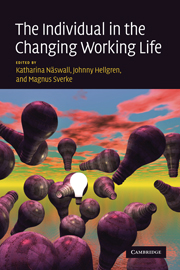Book contents
- Frontmatter
- Contents
- List of figures
- List of tables
- List of cases
- List of contributors
- Acknowledgements
- 1 The individual in the changing working life: introduction
- Part I Threats and challenges
- 2 New rules of work: exploring the boundaryless job
- 3 Changing work roles: new demands and challenges
- 4 The Demand-Induced Strain Compensation model: renewed theoretical considerations and empirical evidence
- 5 Job insecurity and employability among temporary workers: a theoretical approach based on the psychological contract
- 6 Independent contracting: finding a balance between flexibility and individual well-being
- 7 Work–family conflict in individuals' lives: prevalence, antecedents, and outcomes
- 8 My love, my life, my everything: work–home interaction among self-employed
- 9 Modern work and safety
- 10 Romantic relationships at work: old issues, new challenges
- 11 Ethnic diversity at work: an overview of theories and research
- Part II Individual attempts at restoring the balance
- Part III Intervention and promotion on the organizational level
- Index
- References
2 - New rules of work: exploring the boundaryless job
Published online by Cambridge University Press: 13 October 2009
- Frontmatter
- Contents
- List of figures
- List of tables
- List of cases
- List of contributors
- Acknowledgements
- 1 The individual in the changing working life: introduction
- Part I Threats and challenges
- 2 New rules of work: exploring the boundaryless job
- 3 Changing work roles: new demands and challenges
- 4 The Demand-Induced Strain Compensation model: renewed theoretical considerations and empirical evidence
- 5 Job insecurity and employability among temporary workers: a theoretical approach based on the psychological contract
- 6 Independent contracting: finding a balance between flexibility and individual well-being
- 7 Work–family conflict in individuals' lives: prevalence, antecedents, and outcomes
- 8 My love, my life, my everything: work–home interaction among self-employed
- 9 Modern work and safety
- 10 Romantic relationships at work: old issues, new challenges
- 11 Ethnic diversity at work: an overview of theories and research
- Part II Individual attempts at restoring the balance
- Part III Intervention and promotion on the organizational level
- Index
- References
Summary
Profit arises out of the inherent, absolute unpredictability of things, out of the sheer brute fact that the results of human activity cannot be anticipated and then only in so far as even a probability calculation in regard to them is impossible and meaningless.
(Knight, 1921: 311)In 1921, Frank H. Knight made a classic distinction between “risk” and “uncertainty” in economic endeavors, claiming that while risk can be calculated, uncertainty cannot. Since then, a variety of methods for assessing and reducing risk have been developed and used, while essentially ignoring uncertainty. In the 1970s, however, in the face of increasing international competition, oil crisis, floating currencies, political unrest, and the idiosyncratic demands of lifestyle consumption, turning a blind eye toward the uncertainties of enterprising was no longer a feasible option. Rather, uncertainty had to be recognized as a fundamental precondition of modern corporations. Out of Japan came the realization that planning and organizing for it, and not just against it, could provide a competitive advantage (Ouchi, 1981; Porter, 1990). The general strategy for coping with uncertainty, introduced by the Japanese, was to increase the flexibility of production (Piore and Sabel, 1984). The principles of flexibility have since been introduced into almost every aspect of corporate life.
- Type
- Chapter
- Information
- The Individual in the Changing Working Life , pp. 19 - 45Publisher: Cambridge University PressPrint publication year: 2008
References
- 18
- Cited by

